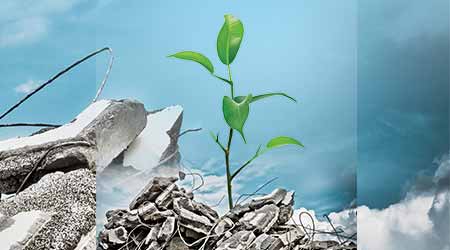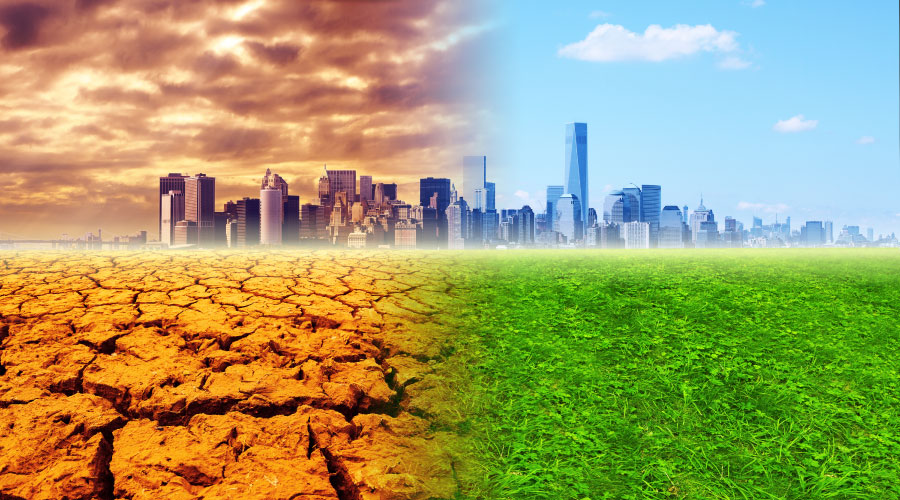Water and Energy Efficiency Are Key Resilience Strategies
While most sustainability strategies complement resiliences, others may require a trade-off evaluation. New rating systems can help facility managers measure resilience.
Water efficiency is useful as a resilience strategy, as well as offering sustainability benefits, for a similar reason as energy efficiency — that is, the ability to stay in operation longer after a disaster. That’s all the more true when the longer-term effects of climate change are factored in. “If there is drought and less water availability, a building that uses less water, and has a system for using recycled water, is more resilient,” says Reis. “If you use less resources, then when less resources are available, you’re better off.”
Related to water efficiency is stormwater management. “Stormwater management is a win-win that’s overlooked,” says Wilson. “A more resilient strategy is to provide onsite infiltration, that is, allowing water to soak into the aquifer on site.” This is also sustainable, and can save significant cost on municipal wastewater charges. Wilson cites a building that transformed all its overflow parking to a “grass paved” system. Another example of stormwater management is a green roof — keeping water literally on the building. Vegetative shading — trees or other plants — also reduces air conditioning load and can protect the building during extreme weather.
Many other exterior elements can be enhanced to improve both sustainability and resilience. Better insulation is a key one because this allows the building to maintain habitability if the grid is down and HVAC is out. “A robust, high-performance building envelope is going to keep occupants safer in the event of an extended power outage,” says Wilson. This is an occupant comfort advantage, but it also saves energy.
Evaluating trade-offs?
With all the ways that sustainability and resilience are complementary, the question naturally arises: If I’m focused on sustainability, is there any way I’m hurting my building’s resilience, or vice versa? That’s not quite the right way to think about the question, say these experts. More often, it’s less about sustainability strategies negatively affecting resilience, and rather about money being spent specifically on resilience that then leaves the coffers bare to do more forward-thinking green strategies — or vice versa.
“Some times, developers may want to harden a building, beef up the foundation, use flood barriers, et cetera, instead of putting money into a better building envelope or other features,” says Wilson. As well, hardscaping a building can make them less inviting by reducing the number of windows, says Pierce.
Wilson says that these redundancies in buildings are at odds with the sustainability concept of resource efficiency. “It requires a value judgment,” he says. “You have to recognize which is more important to your organization.”
Reis mentions the reverse problem: 1980s buildings that used fewer beams and columns to make space floorplates more open, and with more bays. In the case of an earthquake, he says, “this focuses the damage into fewer members. Each becomes more important. Damage to one member can lead to cascading failure.”
Another possible conflict is diesel generators — having available and immediate backup power certainly makes a building more resilient, but it’d be hard to argue that large-scale generator use doesn’t have a negative effect on air quality.
Pierce mentions one final conflict: complexity. Resilient buildings often include passive energy and survivability strategies — like operable windows, other daylighting, and other natural ventilation. “Buildings must be efficient, but simple enough that they can be run off grid and still maintain efficiency,” Pierce says.
Facility managers are well-versed in evaluating trade-offs, but most experts say the trade-offs between sustainability and resilience are negligible. “Sustainability and resilience are pretty well aligned,” says Grayson.
Measuring resilience
In August 2014, the RELi Cooperative, led by Pierce, released a comprehensive rating system — the RELi Resilience Action List — aimed at quantifying resilience in buildings. The rating system borrows heavily from other existing rating systems, like LEED, but also forges its own path with new credits specifically focused on resilience for both new and existing buildings.
In 2015, the U.S. Green Building Council approved three LEED pilot credits focused on resilience. Wilson and the Resilient Design Institute were instrumental in advocating for the approval of these credits. Currently, these credits are undergoing revision, with new versions expected to be released later in 2017. Also in 2015, the U.S. Resiliency Council released its own rating system largely focused on buildings’ resilience to earthquakes. And yet another rating system — the Resilience-based Earthquake Design Initiative (REDi), developed by design and engineering firm Arup — also provides instruction on designing earthquake-resistant buildings. (See “Know your resilience guidance systems” for more on these.)
These rating systems all attempt to do what LEED and other rating systems have done for sustainability: Measure and quantify. The difficulty with resilience, of course, is that it’s impossible to know for sure how resilient a building is until there is a disaster. “The best time to measure resilience is after a disaster,” says Grayson. “You can then see how quickly you came back online, or if you stayed online.”
But resilience can still be measured in a few ways prior to a disaster. One approach, says Pierce, is to calculate risk in terms of dollars potentially lost, akin to strategies employed by insurance companies. “What is your exposure to monetary loss by loss of business, if you’re down for a week, if you lose all your sales for a month, et cetera?” he says. “You also have to take into account the dollar amount for lost credibility or penalty to a brand.”
Wilson says it’s also possible to quantify passive survivability in thermal models. This gives an idea of how long occupants will be safe in a building without power. And, he emphasizes, it’s not just about temperature, but also humidity. This is the focus of LEED Pilot Credit IPpc100 — Passive Survivability and Functioning During Emergencies, a pilot credit that includes guidance on thermal resilience, back-up power, and access to potable water, all with the safety and health of occupants in mind.
“If we do a good job of advancing resilience,” says Wilson, “the benefits for life-safety are tangible and real.”
Indeed, the safety of occupants should be at the forefront of any attempt to measure the resilience of a building, says Reis. He says any attempt to measure resilience in a building must incorporate three things, which happen to be the three categories on which the U.S. Resiliency Council’s rating system rates buildings: Safety of occupants, damage and repair costs, and recovery time. He says considering these three things, as well, is really where resilience meets sustainability. “A sustainable building leads to reduced recovery time,” he says. “If power and water are available on site, then the building can bounce back quicker. The more a building can be less dependent on external factors, the more resilient it is.”
Email comments and questions to
greg.zimmerman@tradepressmedia.com.
Related Topics:














